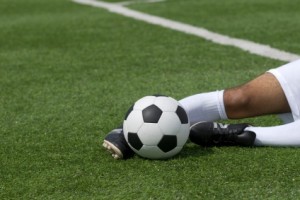No matter what a player’s position during a game, command of the ball is very important. The ability to control an  erratic ball quickly and efficiently gives great personal satisfaction, is fun to watch, and can be the difference between success and failure in any situation in the course of play.
erratic ball quickly and efficiently gives great personal satisfaction, is fun to watch, and can be the difference between success and failure in any situation in the course of play.
Soccer demands speed so there is a big requirement for first-time passing. This, however, can’t always be put into practice. The ball must be trapped or stopped, or the player may have to dribble with it because no teammate is in a position to receive a first-time pass. Time and space are like gold in soccer.
The less time a player takes to do something, the more time he’ll have to take advantage of situations. A player will do one of three things after taking control of a ball:
1) He’ll screen the ball by positioning his body between the ball and his immediate opponent.
2) He’ll pass the ball or shoot.
3) He’ll dribble the ball.
The space and time he’s given to do these things will depend on how good he is at receiving the ball in the first place.
Let’s go over a couple of soccer drills that will help develop foot-trapping skills.
Teach your players to try to cultivate a feel for the ball. Feel means a fine tenderness with the ball. Good trapping is like an art. Tell your team to pass a ball with a friend or find a wall so that the ball rebounds.
As the ball is coming to you make sure your body is in the line of flight. As it arrives the controlling foot should be slightly in front of the standing foot. At the moment contact is made the controlling leg should immediately start moving backwards from the hip. The controlling surface should relax and the movement should be gauged to be almost as fast as the speed of the ball. This allows the contact with the inside of the foot to last as long as possible. In this way the foot can take the pace off the ball so that it comes to a stop at a point just in front of the foot.
In words, this sounds difficult but it’s really not. You’ll have young players on your team that are naturally good at trapping the ball. Most players don’t get really good at this skill until they’re over 10 years old. If you’re a coach of kindergarten to pee wee age players, now is the time to start teaching this skill because they’ll need it in the future.
Now get your friend to play the ball at you while another player is marking you. Not only must you concentrate on trapping the ball cleanly but you must make sure you move to meet it or the marking player will get it first. Having taken possession, screen it for a few seconds before playing it back to your friend. After a little practice, try taking the ball to one side either by using the inside or outside of your foot. The object here is to move onto the ball played by your friend and as the ball arrives to take it quickly to the left or right. Again, touch is vital. If you do not play the ball hard enough, you’re likely to fall over it. If you play it too hard, you’ll lose control.
The ability to control the ball with the feet is basic to soccer. It is a skill that is totally instinctive to some, but that’s harder for others. But at whatever level you play, your control can always benefit from practice.


No comments yet.